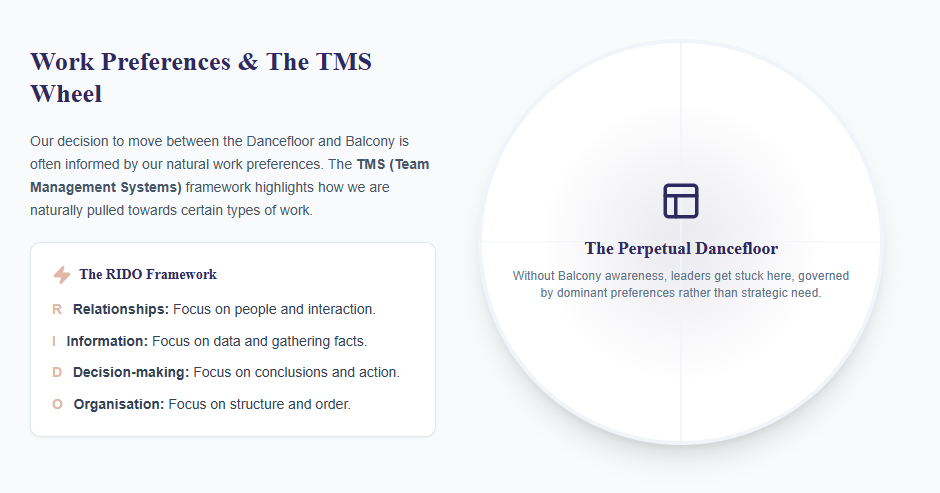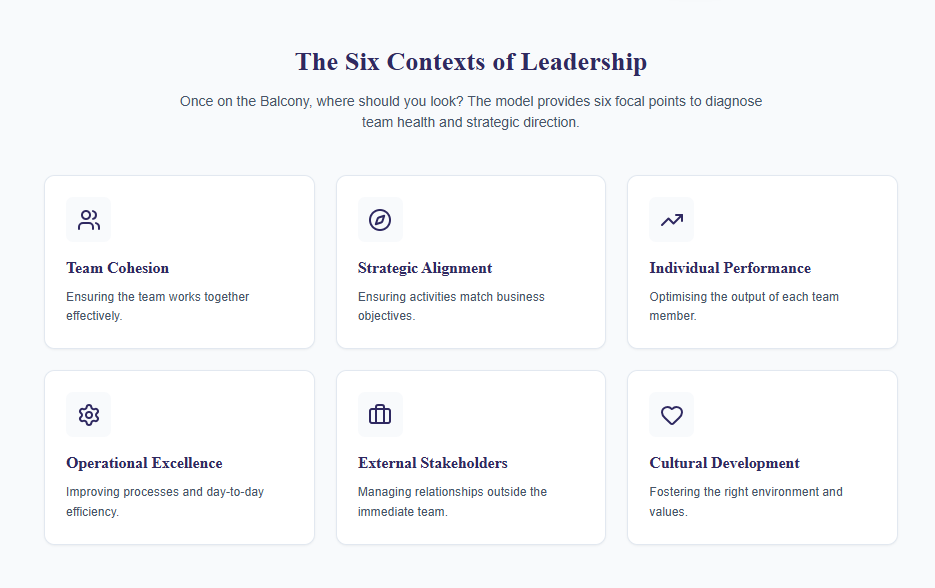No products in the cart.
26th November 2025
The Dancefloor vs. The Balcony: A Leader’s Perspective
Anchor Excellence
Effective leadership often hinges on the ability to shift perspective, moving seamlessly between the immediate action and the broader strategic view. This dynamic is beautifully captured by the metaphor of the Dancefloor and the Balcony—a key perspective for any leader seeking conscious and impactful engagement. This model, often attributed to the work on adaptive leadership, is more than just a conceptual tool; it’s a practical mechanism for self-correction and strategic course-setting.
Dancefloor
The day-to-day operational reality. A fast-paced environment where work gets done. It involves direct involvement, collaborating, and responding instantly to challenges.
The Dancefloor represents the day-to-day operational reality: the fast-paced, high-energy environment where work gets done. It’s where you are directly involved with the team, collaborating, problem-solving, and responding instantly to the hum and movement of immediate challenges. Leaders on the Dancefloor are deep in the execution, feeling the pulse of the team, ensuring tasks move forward, and managing the inevitable minor crises that arise. It is the place of essential detail, direct communication, and rapid response. While vital for execution, remaining solely on the dance floor means operating in a state of constant reaction, prioritising urgency over importance.
Balcony
The strategic vantage point. It provides distance to observe patterns, understand context, and determine where energy should be placed to align with long-term goals.
The Balcony, in contrast, represents the strategic vantage point. From the Balcony, a leader gains a necessary distance—both physical and psychological—to observe the patterns on the dance floor. It allows a leader to see who is dancing with whom, what routines are dominating the floor, and what parts of the floor are empty or overcrowded. This distance is crucial for considering the larger context of the organisation’s vision, strategic imperatives, and key business objectives. It’s the place for deep reflection, for purposeful decision-making, and for determining where energy and focus should be strategically placed to ensure the collective effort aligns with long-term goals. The Balcony perspective transforms activity into intentional action. Leveraging the Team Management Systems (TMS) Framework.

The decision to move between the Dancefloor and the Balcony can be deeply informed by self-awareness, particularly concerning one’s natural work preferences. As a TMS practitioner, I understand that leaders and team members possess distinct work preferences. The Team Management Profile (TMP) provides deep insights into these preferences through the Types of Work model, which is visually represented by the TMS Wheel. All work, regardless of its nature, can be assessed against these eight key types.
Our individual work preferences—shaped by our RIDO framework (focused on Relationships, Information, Decision-making, and Organisation)—naturally pull us towards certain types of work on the wheel. For example, a leader with a strong preference for Controlling and Organising might naturally gravitate toward micromanaging on the dance floor, ensuring all steps are executed to a precise rhythm. Conversely, a leader with a preference for Exploring and Innovating might struggle with the execution-focused details of the Dancefloor, needing the strategic space of the Balcony to feel effective.
However, our actual work often requires us to operate across multiple segments of the wheel. It is entirely possible (depending on your role and context) that you may need a more “Green” focus (for example, concentrating on Advising and Gathering Information) to assess a market opportunity, or a more “Purple” focus (for example, concentrating on Producing and maintaining Accountability) to deliver results on a critical project deadline.
A leader’s natural work preference is a powerhouse, driving unconscious competence and high output in their preferred areas. However, this powerhouse also comes with potential downsides. The Risk of the Perpetual Dancefloor
When a leader operates without awareness (not on the Balcony), they risk becoming perpetually stuck on the Dancefloor, their actions governed by their dominant preference, rather than the strategic needs of the moment.
A leader who rarely steps up to the Balcony is solely on the Dancefloor, constantly reverberating or moving to the rhythm of others. They are reacting rather than intentionally directing. They run the risk of failing to take the necessary time to determine where they should actually place their foot or in which direction the collective effort needs to move. They can become a bottleneck, confusing constant motion with meaningful progress. This state of operational overdrive leads to strategic drift, where the team is busy and exhausted but not aligned with the key business objectives. Anyone caught in a mosh pit—being tossed by external forces with little control over their own direction—can instantly grasp this feeling. The Perpetual Dancefloor is a place of burnout, low impact, and strategic chaos.

This is where the Six Contexts of Leadership model becomes invaluable. It provides a structured framework of the different focal points a leader can consciously choose to concentrate on, moving beyond mere preference. When we layer the Balcony perspective over this model, we can purposefully reflect on which context—be it team cohesion, strategic alignment, individual performance, operational excellence, external stakeholder management, or cultural development—requires our attention. The Balcony provides the clarity to diagnose the team’s current state and choose the appropriate context to focus on.
Being on the Balcony is not a one-time event; it is part of the evolving capability of a conscious leader. It is the disciplined act of pausing, reflecting, and recalibrating. A greater awareness of our TMS work preferences, combined with the strategic perspective gained from the Balcony, enables a more purposeful and conscious approach to operating. It allows the leader to choose which context they are operating in and how best to harness their energies for maximum strategic impact, rather than simply moving to the path of least resistance or strongest preference.
If you feel your team is lost on the dancefloor, demonstrating high activity but low strategic alignment, then reach out to us for a tailored solution to integrate the Balcony perspective into your leadership practices.

